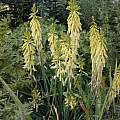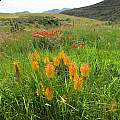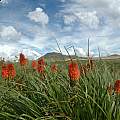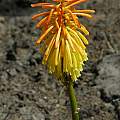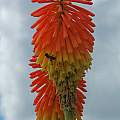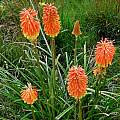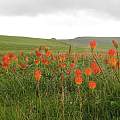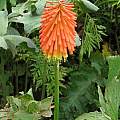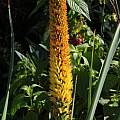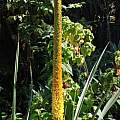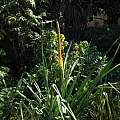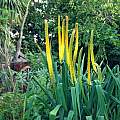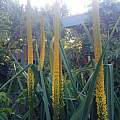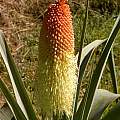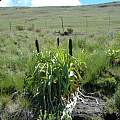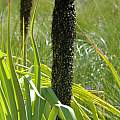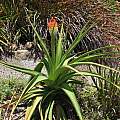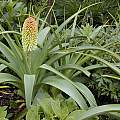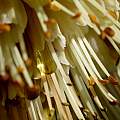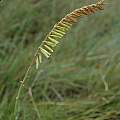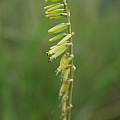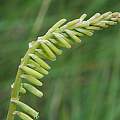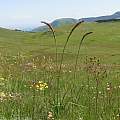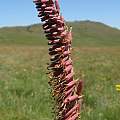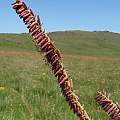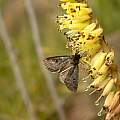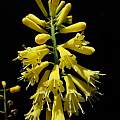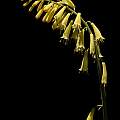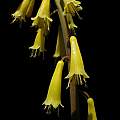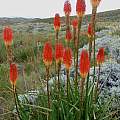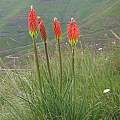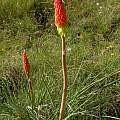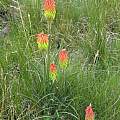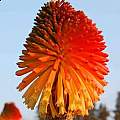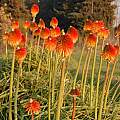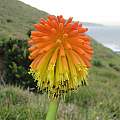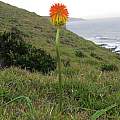Kniphofia is a large genus of about 70 Species in the Asphodelaceae family that are rhizomatous or have fleshy roots. They are from Africa, Madagascar and Yemen. Most of the species are from Africa, especially South Africa and many of the popular cultivars originated from South African species.
Page 1: K. acraea... Page 3: K. sarmentosa...
Kniphofia ichopensis Schinz grows solitary or in small groups at marshy places in the Natal midlands. The plants have dull green distichous leaves and mostly yellow or, rarely, salmon pink flowers in a lax inflorescence. Stamens are only slightly exerted from the long slender perianth tubes at anthesis and later withdrawn. Main flowering time is summer, but may sometimes occur as early as November or as late as April. Photo from Ellen Hornig.
Kniphofia linearifolia Baker is widespread in the Eastern Cape where it grows in marshy ground and near stream beds, often in large colonies. It was one of the first species introduced to Europe and has often been mixed up with the more delicate Kniphofia uvaria in early taxonomic treatings. Growing up to 1.5 m tall, it has yellow green strongly keeled leaves and a dense inflorescence. The stamens hardly protrude. Photos taken January 2010 near Lady Grey by Cameron McMaster, Bob Rutemoeller, and Mary Sue Ittner.
Photos below taken by Cameron McMaster in Maclear.
Kniphofia multiflora J.M.Wood & M.S.Evans is the largest species in the genus. Everything about it is big relative to the other species in the genus. It grows in the summer and goes completely dormant in the winter, dropping all of its leaves. There are two color forms which roughly correlate with distribution, with whitish to cream flowers in the south, and the typical Kniphofia orange/yellow color scheme further north. Unlike most other Kniphofias, the individual flowers stand up even in full bloom, giving the exceptionally long inflorescence a fuzzy look with their exerted stamens and styles.
During growth, it likes lots of water and can multiply from a small seedling into a gigantic plant as seen in the photo in just three years! Photos 1-3 were taken by Nhu Nguyen of the plant at the end of its second year. Photos 4-5 were taken by Uluwehi Knecht of the much larger cluster in bloom during its third growing season.
Kniphofia northiae Baker is a very robust species that grows to 1.7 m tall, and one of two species forming a mostly unbranched stem. It is found on mountain grassland, on streambanks, basalt cliffs, seepage lines up to 300 m from the Eastern Cape to KwaZulu-Natal. It has large recurved aloe-like leaves and a dense inflorescence with whitish or orange-red to yellow flowers. Photo #1 from Cameron McMaster shows the flower. Photos #2-3 by Bob Rutemoeller taken January 2010 at Naude's Nek. Photo #4 by Mary Sue Ittner taken January 2010 at Gaika's Kop.
The first photo was taken by Nhu Nguyen at the UC Botanical Garden. The second was taken by Ellen Hornig. The last by Martin Bohnet shows the copious amount of nectar produced, as it is typical for bird-pollinated species.
Kniphofia parviflora Kunth is found in grassland and marshy places up to 2000 m from the Eastern Cape to KwaZulu-Natal. Plants are usually solitary and range in size from 25 to 80 cm. Leaves are recurved and keeled with smooth margins. Flowers are scented, one-sided with greenish brown to maroon hanging buds and small creamy green to yellow flowers. Photos 1-3 were taken in January 2010 by Mary Sue Ittner at Satansnek Pass and Maclear.
Photos from Cameron McMaster taken in the Eastern Cape. The first three photos were taken at Tordoon and the last at Mount Thomas.
Kniphofia pauciflora Baker is native to KwaZulu-Natal, where it grows on marshy grassland, though it has vanished from the type location due to draining of the area. The photos below were taken by Nhu Nguyen and Uluwehi Knecht.
Kniphofia praecox Baker is found on streambanks and wet hollows from the Swartberg Mountains to the Eastern Cape. Growing from 1.5 to 2 m, usually in clumps, it has strap-shaped keeled leaves usually with small teeth along the margins. Flowers are in cylindrical racemes, reddish in bud, opening yellow to yellow green with exserted anthers. Flowering in summer (November to January), it is easily mistaken for Kniphofia uvaria, but is more robust with spear-shaped bracts at the base of the flowers. According to Kew this species is now considered to be a hybrid, Kniphofia × praecox Baker, between Kniphofia bruceae and Kniphofia uvaria. Photo and some text from the book Plants of the Klein Karoo courtesy of Jan and Anne Lise Schutte-Vlok.
Kniphofia ritualis Codd is common in grassy mountain slopes and shallow soil and rock crevices in Lesotho and adjoining areas at altitudes of 1600 to 2800 m. Leaves are soft, spreading, deeply keeled with finely toothed margins. The leaves have been used for plaiting ropes. The dense inflorescenses follow the common color scheme of reddish buds opening to greenish-yellow flowers. As the epithet ritualis implies, this species was actually used in local women's initiation rites. It has also been used in traditional medicine to treat pain. This species is very similar to Kniphofia caulescens, but that species has shorter flowers and markedly exserted stamens. Photos taken by Cameron McMaster at Naude's Nek.
Kniphofia rooperi (T.Moore) Lem. has a typical compressed triangular flower spike in the early stages. Its colours graduate from cream, orange to green at the top. It originates from the milder coastal area of east South Africa. It flowers in mid-winter and is therefore well adapted to the mild Mediterranean climate, but prefers marshy ground and will stay significantly smaller if held too dry.
In August with drought and high temperatures the plant slows down. This is the best moment to prune off the superfluous leaves. After 4-5 years in place it is advised, in order to maintain a generous flowering, to divide the rhizomes (end of summer or late winter). An ideal plant to colour your driveway in midwinter. Photos 1-2 were taken by Lauw de Jager in his garden (South of France) in February 2008. Photos 3-4 were taken by Cameron McMaster January 2010 at Morgan Bay in the Eastern Cape. Although it mainly flowers in mid-winter, Cameron reports that it flowers opportunistically at other times of the year.
Page 1: K. acraea... Page 3: K. sarmentosa...
